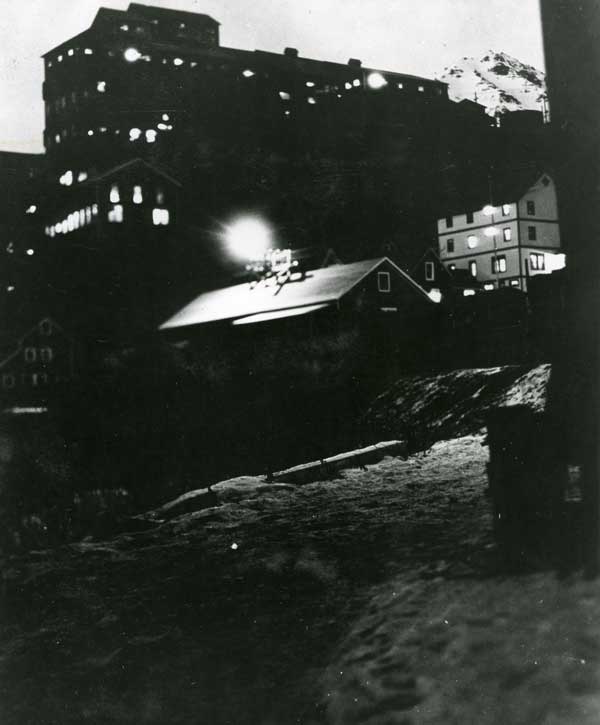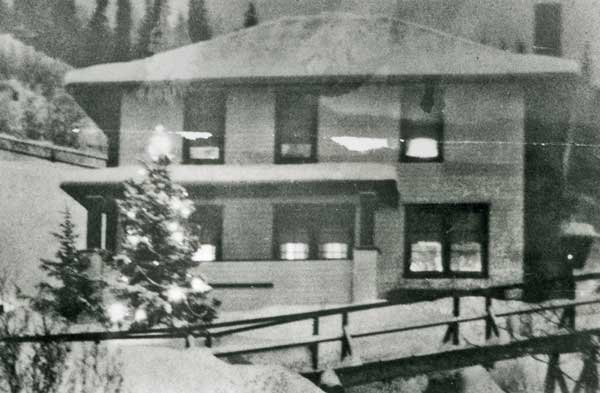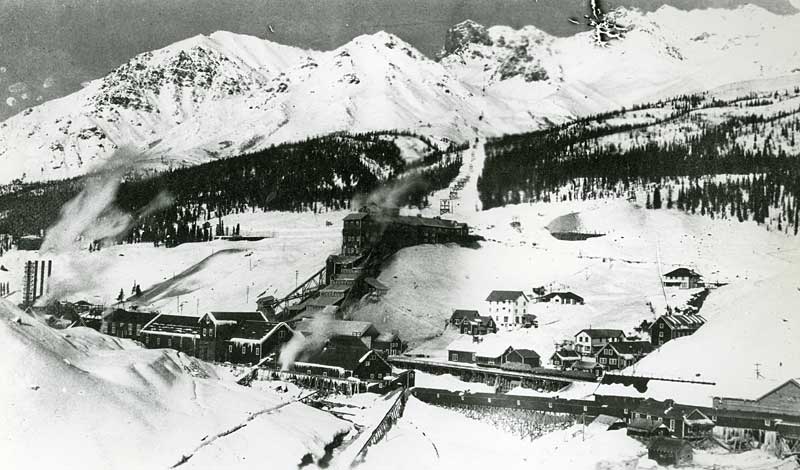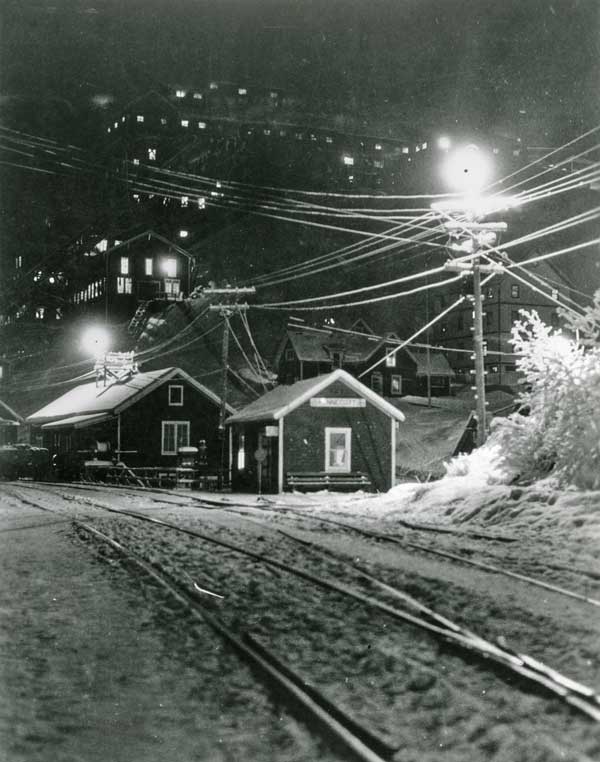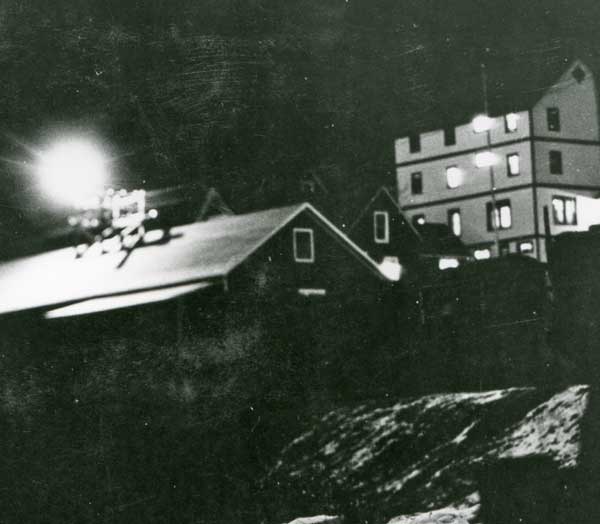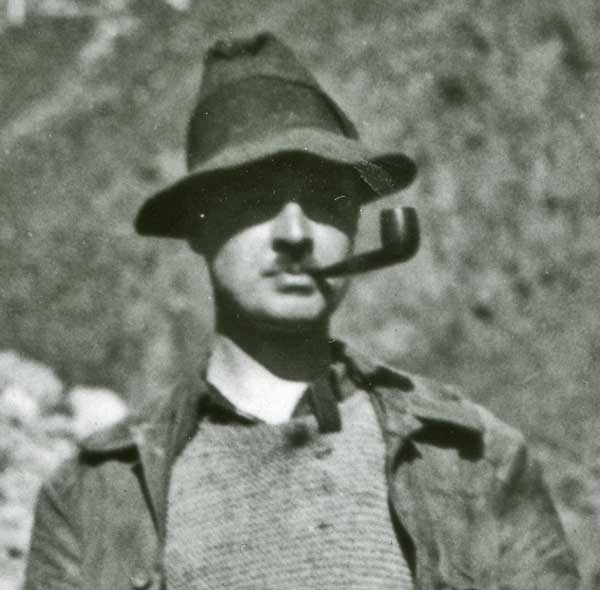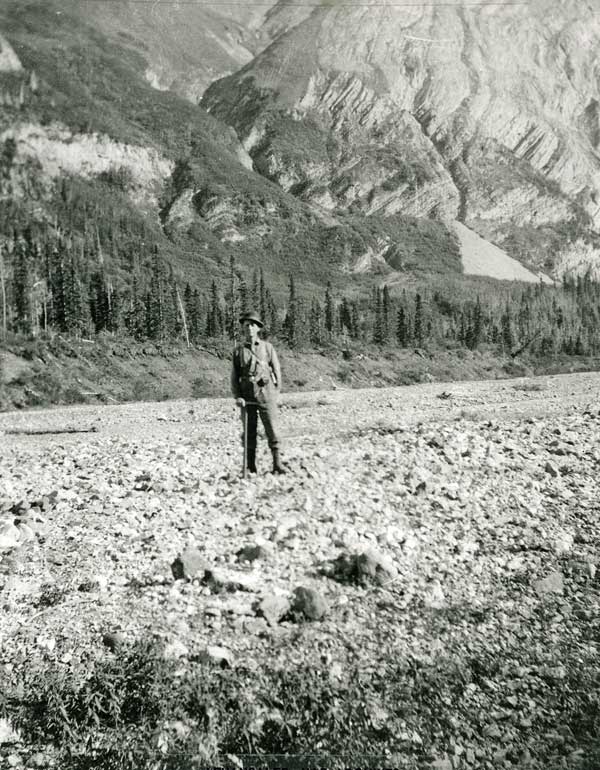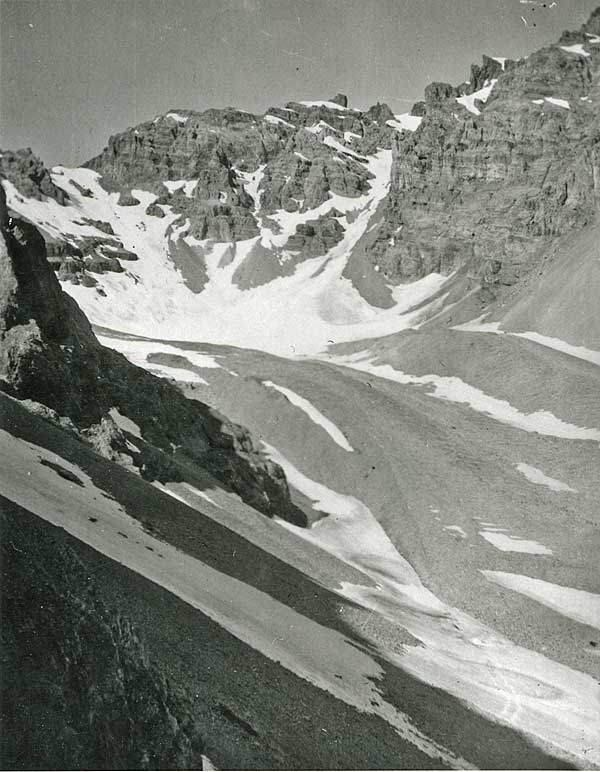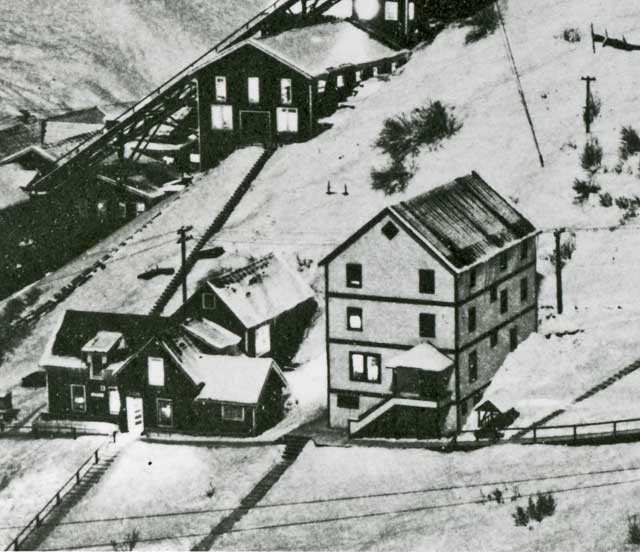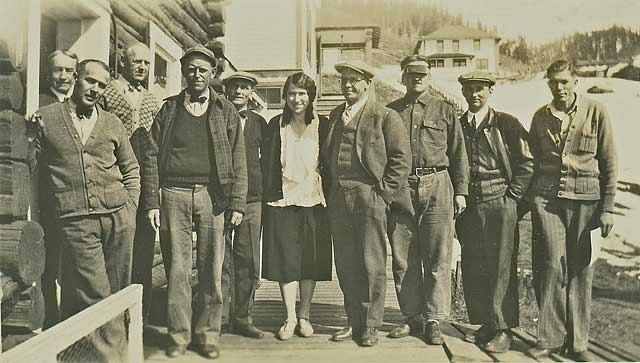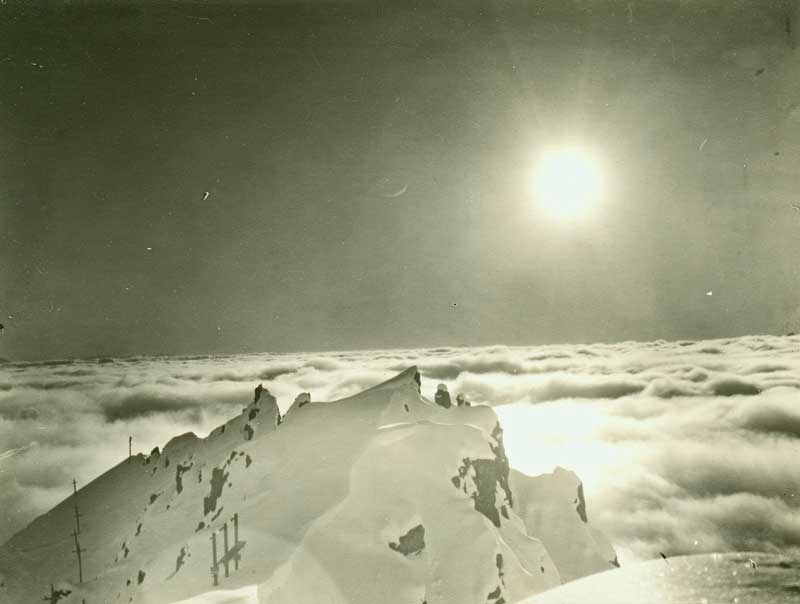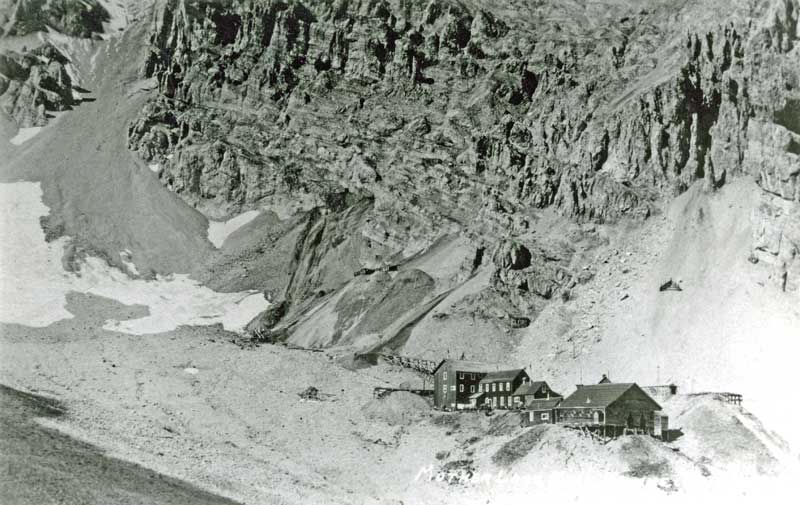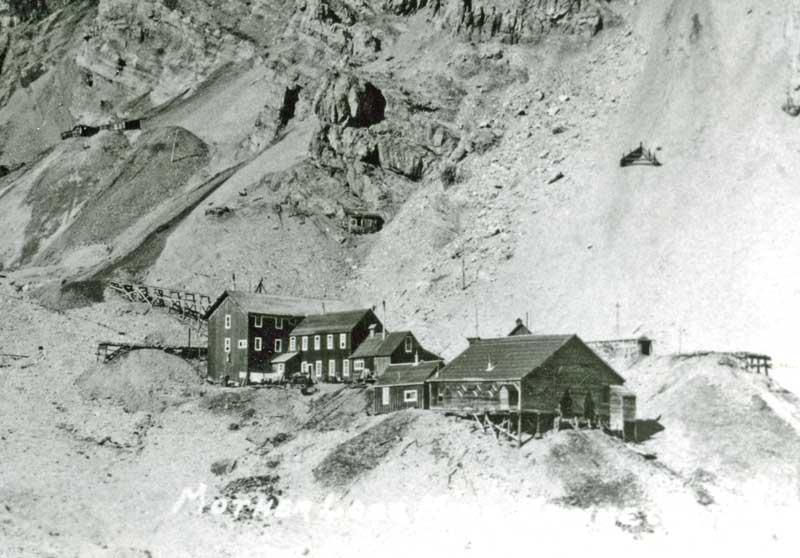Power was to originate from a dam about two miles down the creek at a narrow point in the canyon, but this plan was abandoned in favor of building a power house right in McCarthy where there was ready access to fuel brought in by the railroad. By 1916 this power plant and a thirteen-mile string of power lines was in operation all the way up the McCarthy Creek canyon to the base and upper camps. A narrow road was also extended from the town, crossing more than a dozen bridges, following the creek grade all the way to the lower camp. This would enable year-around transporting of ore from the mine to town, where it could be loaded at Shushanna Junction, which was the railroad yard near McCarthy. Ore had been hauled only in the winter, sledded down the creek in limited quantities. Although there was now a road and power, there still remained the need for a mill, as it was only economical to ship very high-grade ore over the Copper River and Northwestern Railway and then the Alaska Steamship Lines to the Tacoma smelter. By 1918, the mine was still only in limited production, as there had not been enough capital raised to build a mill or purchase special ore trucks to run the narrow road to McCarthy. Almost all of the development had been limited to the Marvelous vein, which lay in the rock face north of the upper camp in the upper elevations of the ridge which separates Mother Lode gulch from Marvelous gulch. Mother Lode was sitting on what appeared to be an ore vein of high potential, but the developers had so far failed to raise the necessary capital for the development required to exploit the situation. Additionally, the company had not been successful in gaining favorable haulage rates from the CRNW Railway, which was wholly-owned by Kennecott Copper, the competition. The Marvelous vein simply did not show enough potential to attract the needed investment capital. What the company failed to realize was that the true “Mother Lode” lay directly beneath the upper camp, not quite 400 feet straight down. Mother Lode Company ran several prospect tunnels searching for the elusive vein which would bring in the investment money before it was too late. A main tunnel, at what was to become the Bonanza 800 level, headed to the northwest for a distance of several hundred feet. They named it the Rhodes tunnel. Directly above it, near the lower limit of Marvelous vein, the Pittsburg tunnel was started. In an attempt to find additional ore, a two-compartment vertical shaft was driven from a point well inside the Rhodes tunnel. The Mother Lode vertical shaft, ultimately extended a vertical distance of 850 feet from the 600 level down to the 1450 level. But most of that work was done by Kennecott. The original tunnel was not successful in driving the tunnel far enough down. Ironically, had the ML extended it another hundred feet in 1918, the old company would have discovered the true Mother Lode and could have found financing independent of theKennecott Corporation. They were on the right track, but they ran out of time. Kennecott would benefit enormously from this failure. Then came the severe winter storms. There had been no storms like these since the railroad arrived. One winter snow storm after another dumped load after load of snow over the entire upper Chitina and Nizina valleys. The build-up was perilously high in late April when the melting actions of early spring finally set off those first avalanches. Every aerial tram on the ridge was damaged by those slides, which increased in frequency and intensity until the upper towers at the Jumbo, Bonanza and Mother Lode mines, along with the power transmission towers, were knocked out of position or completely destroyed. The two Kennecott upper camps were isolated for days, having no form of communication due to the lines being down and tram access gone as well. But it was much worse at Mother Lode. The upper camp was severely damaged and most of the tram towers were completely down. The power line which followed the creek floor was heavily damaged as well. The men who were at the upper camp had to stay in the tunnels while the avalanches were busy taking out everything in sight. Remarkably, the main part of the upper camp was repairable, as it was above the area where most of the snow slides occurred. But an already cash-strapped company now needed to make some sort of deal with Kennecott--something which had been avoided up until now. There was no other choice if there was any hope of holding onto the already considerable investment at Mother Lode. Although Kennecott had experienced considerable damage as well, the corporation had deep pockets and was prepared to handle emergencies of this kind. It also had the investment capital on hand for the right opportunity to buy into the Mother Lode operation across the ridge.
He paused long enough to look up toward the dark hulk on the hill. The Stephen Birch guest house was now barely visible through the darkness and blowing snow. Frank again stood up and pressed is face against the cold glass. It was really dark out there. The lights in the Douglass house had gone out. Only the dim porch lights of the three entryways on the upper level of the hospital could be seen. He sat back down and took a sip of the tea. Ellen had sweetened it slightly with sugar and lemon. It was a pleasantly hot treat. He could feel coolness coming through the glass and maybe even the walls. Frank pulled the heavy robe more tightly around himself and continued. The early owners of Kennecott--the Alaska Syndicate, which mainly consisted of the Guggenheim family, J.P.Morgan, and just a few others--had the opportunity early on to pick up the Mother Lode claims, but failed to do so. Ocha Potter, representing Mother Lode, had tried to interest them before any development work began there, but the syndicate’s consulting engineer failed to make a close inspection of the site. He was too old and did not want to make the long climb up the hill. He concluded that there would was no copper of any economic value in the ML properties. That was the end of that for a while. Mother Lode worked the Marvelous vein, which is the reason we are re-opening the camp over there. We have decided to complete the work the old company left behind at Mother Lode in order to determine the likelihood of any adjacent large copper ore bodies. But Marvelous, by itself, would not have been enough to interest Kennecott into picking up the entire site. However, by 1914, a new much younger consulting engineer took another look at the lay of the Bonanza vein and concluded that it probably extended well into the adjacent Mother Lode properties. He projected the main vein at about 400 feet below the main adit at Mother Lode. This information was kept confidential. But Kennecott was now ready to take advantage of any situation which would give it control over the adjacent properties. Then came the snow slides of 1918. In very short order, the deal was made, and an all-new Mother Lode Coaltions Company was formed. As an interesting side note to all of this, when Kennecott picked up ML, it also obtained the power plant at McCarthy. This continued to operate until power could be run over to the ML workings through the 800 crosscut. Then the plant at McCarthy was shut down. It was still sitting completely intact when the Kennecott power plant burned down two years ago. The availability of those generators allowed us to resume operation that year much earlier than would otherwise have been possible. I have written enough about ML. Thank you for tolerating my probably boring letter. But then, as a fellow engineer, you can understand that. I must admit that this time of year, with no family, it is good to have a few old friends with whom I can correspond. Thanksgiving day is just around the corner here. The company provides a special dinner to all of us on that day, but I’ll probably enjoy a dinner with the other engineers at the superintendent’s home. I have never lost my fondness for turkey with all the trimmings. If I recall we were taught as schoolchildren that the Indians saved the first of us white people by providing badly needed food. We have two Indians--they’re called ‘Natives’ up here--who are now working at Erie. I was able to convince the super to hire them for the first time back in 1924. I had met one of them the year before when I took the train in from Cordova in a very strange place called Chitina. This Native, who is about my age, works with a cousin who calls himself Cap.The two of them have worked here three times. They have added much to this camp. It has never been so interesting, even though the two of them think they are making themselves inconspicuous. The team works so well together and is so daring in what they do that they far outshine almost everyone else. They have proven to be about the finest workers I have ever encountered. I understand that they will be assigned to the Marvelous Project. With them there, I will probably never have a dull moment. I might add that those two are literate and surprisingly articulate. Never let it be said that the “lowly Indian” cannot take care of himself. These two are living examples of the best there is in Alaska. They take extreme pride in their work, they work very hard, they think the problem through, and they won’t let anyone tell them “it can’t be done.” That happens to be a description of the ideal engineer and miner at Kennecott. That is what Kennecott is all about. I certainly miss those old days on the ranch in Wyoming, but that’s becoming a distant memory now. Be sure to write back and let me know how things are progressing for you at Anaconda’s Butte Mine. With many regards, Your old friend in the north country, Frank Buckner 12 November, 1926 Kennecott, Territory of Alaska
|
Chapters from the historic novel "Legacy of the Chief," by Ronald Simpson, and other items mostly related to the historic background of the Ahtnas in the context of Kennecott Copper & its Copper River & Northwestern Railway.
10 February 2011
Ch 46, Pt 2: "Frank's Thanksgiving Letter"
Ch 46, Pt 1: "Frank's Thanksgiving Letter"
Legacy of the Chief, Pt 1, Ch 46: "Frank's Thanksgiving Letter-1926" |
click on picture for larger image: some of these images appear in the book for this chapter. |
Chapter 45: "The Marvelous Assignment"
The weather pattern was similar to one which had occurred nine years before that forced the end of old Mother Lode company. There had been a steady build-up of snow in the higher elevations as storm after storm dumped its load over Bonanza Ridge. Chief Engineer Richelsen had recommended that Kennecott permanently close the Mother Lode upper camp due to the ongoing danger of avalanches. Bill Douglass concurred because production at the Mother Lode was declining and the Mother Lode miners could easily be housed at the Bonanza camp. Indeed it made more sense, given the new arrangement of crosscut tunnels at the 800 and 1,250 levels, to house both the Bonanza and Mother Lode crews at Bonanza upper camp, which could bed 124, which was well above what was needed in 1926. It was a relatively fast ride down that Bonanza 30 degree incline shaft to the Mother Lode workings which began at the 1257 cross-cut tunnel. The cross-cut was located near the bottom of the Bonanza incline shaft. The 1257 cross-cut was a major haulage tunnel that ended at the top of the Mother Lode incline shaft. At that point there was easy access to the 1250, 1400 and 1600 levels that were under development by 1922. The Bonanza-Mother Lode was a single vein, extending from the top of the Bonanza to a point well inside the Mother Lode. The mines were contiguous, lying along the same thirty-degree plane. Even though the mines were separated by a line on a map and were headed by different corporations, they were in reality a single mine with the main adit and camp being the Bonanza. Every underground working from Erie to Mother Lode was connected except the Marvelous tunnels. The Marvelous was the original Mother Lode. The workings had been discontinued in 1918 as unimportant. In late 1926 the time finally arrived when they would be reopened to ensure that all possibilities of large ore extensions had been thoroughly eliminated before the area was completely ,abandoned.
The reason for the location Marvelous vein was a mystery. Except for the Slurry vein in the Jumbo workings, all of the ore bodies were found fifty to seventy-five feet above the contact zone that separated the unproductive Nicolai greenstone from the ore-bearing Chitistone limestone. The Marvelous vein had assay reports showing seventy percent pure copper, yet it was hundreds of feet above the contact zone. It failed to fit the ore profile, but there it was anyway. When Kennecott took over the Mother Lode workings in 1918, it deemed the Marvelous a fluke and ordered the work there discontinued. While the Marvelous was the original showing and the only copper vein exploited by the old Mother Lode company, the Kennecott engineers realized that the real Mother Lode of copper ore had to exist in a direct line with the Bonanza contact zone. Wes Dunkle projected a large orebody just beyond the Bonanza vein. He was quickly proved correct when the Kennecott miners encountered the fabulously rich 1252 stope in August of 1918, only months after Mother Lode was absorbed by Kennecott. With the projected end of all the copper mines in sight, it was time to examine the remote possibility that an orebody could run from high up the Mother Lode Gulch and continue well into the adjacent Marvelous Gulch to the northeast along the same strike as the other veins, but well above the main vein. It would require following the existing Marvelous workings and mining them out to expose all the ore at that level. The main reason the Marvelous had been left alone for so long was its isolated position. It would have to be connected to the rest of the mine system by running a raise from the Bonanza-Mother Lode 800 level to the Marvelous 600 level. It would also be necessary to extend the Mother Lodge vertical shaft upward to meet the 600 level. The 800 level is one of the first of two main crosscuts that allowed haulage from the Mother Lode workings to the Bonanza incline. To save time and to avoid the cost of extensive tunneling in order to properly connect the Marvelous to the main system, the engineers concluded that it made more sense to reoccupy the old camp, located 5,200 feet above sea level on the McCarthy Creek side, at the end of the 800 cross-cut, also known as the Rhodes tunnel. The old camp had a jig-back tram which facilitated travel to the 600 level adit, which was the base level for the upper Marvelous workings. The men would be able to readily access these workings by staying at the old camp while dropping the ore down the new chute that dropped into the Rhodes tunnel. The upper Marvelous was relatively close to the top of the ridge, resulting in considerable water seepage into the upper workings--a problem that was common to the upper levels of Bonanza and Jumbo. The problem at Marvelous was more severe because it was considerably closer to the surface. There is much less ridge above those workings than anywhere else. The Jumbo adit was a thousand feet below the top of Castle Rock, just as the Bonanza workings were about a thousand feet below the top of Bonanza Peak. The Marvelous, at one point was only a hundred feet or less from the top of the ridge. This was the point where the ridge separating the two gulches dipped steeply toward the McCarthy Creek canyon. The snow tended to accumulate to great levels from the top of Bonanza Peak on down to the area just above Mother Lode upper camp. The camp was in a narrow gulch with a steep ridge to the north and a glacial cirque to the west. The proximity of these two high points to the camp left the Mother Lode in constant danger of inundation by avalanche. The meeting among all the engineers to discuss the Marvelous took place late in 1926 in the map room. “I am opposed to reopening that Marvelous area, especially if it also means opening the upper Mother Lode camp. If we must do it, we need to extend the tunnel system so the men can easily access it from Bonanza.” “We are well aware of your strong opposition, Walt. What about you, Melvin?” “I have to admit that Walt could be right. That is a very dangerous area, especially during the season we’re considering for the exploratory operation. The seepage problem is bad enough, but that avalanche danger, especially with the heavy snowfall so far this winter, is at least as bad as it was when we first acquired Mother Lode. I sure would not want to be the resident engineer in charge of that project.” Bill looked around the table. The concern in the eyes of most all the engineers was difficult to mistake for simple worry. It verged on genuine alarm.
“Your concerns are noted, but I have the orders right here from my bosses, Mr. Nieding and, more importantly, Mr. Stannard. He wants the area mined and the exploration completed so we can permanently close Marvelous out. And he wants it done as soon as possible. I understand that he’s been pressured from the stockholders of Mother Lode Coalitions Company. Some of them are large investors of great power who are not at all happy with their returns for 1925 and 1926.” “They were all stockholders when the Marvelous was being mined. Now they want the work finished. They seem to think that there really is a large orebody there which would justify extending our tunnel system in that direction.” “Damned that Bateman,” someone was heard to mutter. “Well, I’d like to think so myself. After all, the prospects for Kennecott have not looked too promising lately. “From the very beginning we’ve built our reputation on our ability to face and overcome adversity. We’re still considered the miracle workers of the copper mining world. Every problem we’ve ever faced has been overcome. The profits for both Kennecott and Mother Lode Coalitions Company reflect that.” “So now it’s come to this, Bill. Is it profits ahead of safety? Is is the considered opinion of the expert engineers against the hopeful wishes of a few greedy investors who’ve already long since made their fortunes? What makes those stockholders experts on Alaska mining, anyway? Not a one of us really believes there’s anything to that Marvelous nonsense. We called it a freak occurrence then and shut it down. It’s like the Nicolai Prospect--all show and no substance. Why risk the men and so much of our resources for something none of us believe in?” Bill leaned back on one of the office chairs rolled into the room for the conference. He lit his pipe and looked out the west-facing windows to the glacier. “Walt, you’re my right-hand man. You’ve been here as long as I have and we’ve all learned to respect your engineering skills. But this is no longer a simple matter of our opinion as to whether the ore is there. These men pay our way. They could close us tomorrow and never miss the place. They haven’t given me any choice. “It’s no longer a matter of whether or not we proceed. It’s how we go about it.” “Then we better plan carefully for safety.” “Even that’s a problem. Charles Earl and C.T. Ulrich want us to close the area out as soon as possible. They’re thinking they can finish mining Mother Lode and get out with a large profit.” “That’s not possible. Not getting out quickly, anyway.” “I know, Melvin. Realistically we’re years away from mining out the property. But this time our expert opinion doesn’t count. So we need an engineer to head the Marvelous Project. I’m giving it a special priority, which means he’ll have the complete resources I have at my disposal, especially the help of all of us.” “Russell, you’re next in line. Do you want this assignment?” Russell Belvedere was known for his willingness to speak out when most of the engineers would say nothing. He had an irreverent streak in him which ran deep, but he was also extremely dedicated to his work and held the respect of his fellow engineers. He was currently assigned to the Jumbo along with Frank Buckner, the junior engineer. They were working on the details for a retreat plan in advance of closing the Jumbo mine down. “Thank you, Mr. Douglass, but I believe that this is a opportunity we owe to Frank here, who has been at the mines three years without having a command assignment like this one. I already have the Jumbo, at least when Mel is elsewhere. I suggest that we give this job to Mr. Buckner.” Russell did not want Marvelous any more than did Melvin Smith, who probably should have been given it due to his level of expertise. All the engineers turned toward Frank, who looked, in his engaging boyish manner, completely surprised and overwhelmed. “Sir, I’ve been ready to take on this or any other command assignment from the moment I arrived here. If none of my seniors wants the job, I’ll be more than willing to take it.” The other engineers nodded their agreement, settling the matter, though Walter Richelsen felt uneasy about the entire process. He even felt a little guilty. This is no job for a junior engineer. That’s a tough one up there. I should do it, I suppose, but Gladys would have a fit. He considered the youth and inexperience of Frank Buckner and almost stood up to volunteer himself instead. But he quickly thought better of it, especially with the disapproving image of Gladys on his mind. He stayed put. The meeting went on as the engineers considered the difficulties with Marvelous in the springtime. The coldest part of the winter time was out of the question because the jig-back tram was too cold to operate then, and because the upper workings would also be too cold due to the proximity to the surface. It would also likely be heavily frosted, creating yet another set of difficult and hazardous working conditions. Furthermore, the upper camp could not be placed back on line until warmer weather moved in without great cost and difficulty. The engineers anticipated workable temperatures by the end of March. The greatest problem then would be the overhead snow which would begin melting into the workings during the warmer daytime hours. That problem would be partly alleviated by running the crew only at night during the freezing temperatures. For by mid-April when operations should be well underway, the daytime warmth would undoubtedly cause some unavoidable water run-off problems into the upper areas, so everything had to be completed in that upper area on a very tight schedule. “I’m assigning a crew of eighteen, and picking the Erie foreman, Eldon Johnson, to head the special crew. He’s well experienced for this sort of operation.” Douglass was looking straight at Frank Buckner. “You’ll be on your own out there, so you’ll have your own cook and waiter. They’ll have to come from the staff already at Bonanza. We’ll move them to the Mother Lode to serve your crew and tend to the barracks facilities. It’s good that you have some practical experience with boilers and electric motors. You’ll need it out there. Frank, you’ll have to see to the safe operation of the jig-back tram motor and the boiler which will heat the camp. Fortunately, the boiler there is a new one, as we just installed it in 1920 when the original proved too small and unreliable for our needs. “The power already runs through to there by way of the 800 crosscut, but the boiler fuel will have to be trammed up McCarthy Creek this winter and then hoisted up the aerial tram at thirteen mile. That means you will also have to see to the operation of the thirty-five horse tram motor from the days of the old company. We rebuilt the entire aerial tram system in 1918 after the last avalanche destroyed most of it. We’ll check it again, of course, but the tram should be in good repair.” “This is beginning to sound like a major operation.” “In a way it is. You get your own camp, Frank. That’s part of it. It also means that a lot of old equipment that hasn’t been used in years has to be tested. “We’ll send the coal for the cook stove up on the same winter sleds with the bunker fuel. We’ll have to clear the McCarthy trail past Green Butte since road hasn’t been used for some time, but that should present no unusual problem. The road to Green Butte remains open, even though that mine stopped production last year. “In conclusion, we’ll take whatever resources we have and use it all to full advantage.” Frank looked at Bill Douglass, Walter Richelsen, Mel Smith, Russell Belvedere and the others and then leaned back on his swivel stool contemplating this. “I’ve no problem making any of that equipment work. I’ve done it enough times before in Montana and even as a boy in Wyoming. But I hear a sound of reluctance to fully back up the Marvelous operation in the tone of your voice. That bothers me.” “I’m sorry, I didn’t mean it to sound that way, ” Douglass replied. “I guess it’s just the over-all tone here since Stephen Birch announced to all of us that we were no longer high on the priority list. Actually, we are not on any priority list. We are essentially on our own to finish this project economically and without extra funds. That’s just the reality of it.” “Frank, you’ll have to ask for volunteers for head cook and waiter-bull-cook. I’m leaving it up to Eldon Johnson, to put together a mining crew. Because of the nature of the work, the crew will be carefully selected. This is not, by any means, an easy assignment, but it is likewise a challenging opportunity which will mean a strong recommendation from me for almost anything you want professionally once you’ve successfully completed this assignment.”
It was snowing heavily outside the office. The top of the mill could no longer be seen, though it was well-lit. Production was still heavy enough to require a night shift at the mill and tram terminal even in mid-winter. With the meeting dismissed, Frank walked with Russell, one of the other unaccompanied engineers up to the three-story staff house, just uphill from the office. They walked up the wide steps onto the covered porch where a door with leaded glass marked the inside stairwell landing. At this first level, which was actually one floor above the sidewalk below, were the two common meeting areas. There were also two guest rooms and two complete bathrooms. On the second and third levels were six rooms each with two full-baths common to each floor. The top level was reserved for the women, including three teachers, two nurses and the stenographer. On the second level lived Russell, Frank and four other engineers. The two most senior engineers, including Melvin Smith, lived on the main level. The others were accompanied by their wives and children. They lived in the cottages. Bill Douglass lived in the house just uphill from the staff house with his four children, wife and a nanny. No one lived in the manager’s house at the top of the walkway since Bert Neiding moved to Seattle in 1924. Frank opened the glass-top door and let Russell enter first. Russell excused himself and headed upstairs to his room. Frank needed time to think. He headed for the living room adjacent to the entryway. This warm corner room overlooked the office. From there, Frank could see Bill Douglass in an animated conversation with Walt Richelsen outside in the blowing snow, where they were just leaving the office. Frank sat back deep into the leather couch. The Regulator clock showed the time as nearly two-thirty in the morning. It had been a very long meeting. Frank began to have doubts about what was about to happen. Am I really up to this assignment? Can I handle this one alone? Why did Walt seem so uneasy about Mother Lode. What was that heated discussion with the superintendent out there in the blowing snow over? Melvin walked in on the way to his room down the hallway on this main floor. He looked at Frank, but only smiled weakly and nodded silently before disappearing down the hallway toward his room. Frank pulled himself out of the soft couch and headed upstairs toward his room in this comfortably warm and even cheerful staff house. Outside the wind had picked up. It was snowing even more heavily, gusting and even drifting. By morning the snow would lie heavily over the entire Kennecott and McCarthy area. The storm would continue, stopping even the train from its normal arrival. It would be a winter no one could forget.
|
Chapter 44: "Kennecott Goes into Subtle Decline," Pt 2
Life at Kennecott went on as usual, but development of the mill site ended in 1923 with the addition of the water flotation plant to enhance an enlarged ammonia treatment system. It was a final piece in a master plan developed by E.T. Stannard years before to effectively process the carbonate ore, which could not be mechanically separated. The installation of these two complementary processes marked a huge step foreword in copper milling efficiency. The final great improvement was completed at the height of production, one year before Stephen Birch’s final visit. Except for the re-building of the destroyed power plant and the addition to the hospital, the mill addition was the last major work ever done at Kennecott.
Up on the ridge, Superintendent Douglass had been developing the Glacier Mine. It was separate from the underground mine system, being primarily an open-pit mine. In 1920 the company built the 5,000-foot-long tram, extending from Jumbo tram station no. three in an easterly direction up to the rock glacier. The mine was a rock glacier consisting of ice mixed with talus containing dolomite limestone and the eroded part of the original Bonanza ore outcropping. Until 1920 the company had been too busy developing high-grade ore veins. Finally the company turned its attention to the surface ore found not only at the rock glacier, but also on the extensive Bonanza talus slide directly below the upper camp.
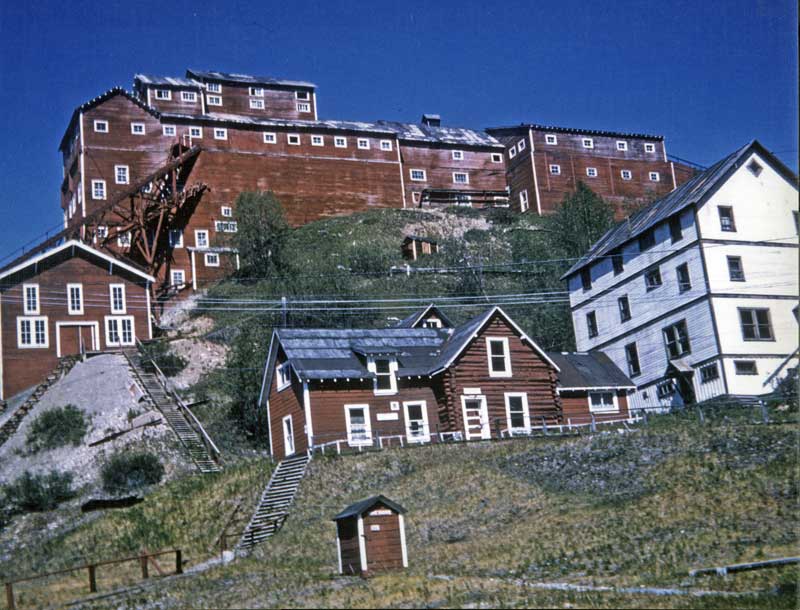 |
| The abandoned mill in 1950 --Charlie Ricci photo |
The Glacier Mine and the Bonanza slide ore was heavily mixed with waste rock and was too lean to process as long as there was an abundant supply of high-grade copper. But those days were soon over. The average content of the high grade ore slipped from seventy percent to about fifty percent by the early 1920s.
Thus the extraction of ores of lesser values began. The expansion of the ammonia leaching plant and the building of the water flotation system allowed for the expanded processing of these lower-value carbonate ores, extending the life of the mine by several years. Yet in the end, even the ammonia leaching plant became too expensive to operate. By then all resources had been placed into the extraction of the remaining floors and pillars--the last of the high-grade ore along the fifty-two miles of underground workings within Bonanza Ridge.
Even while Kennecott committed more money into the milling process to extend the life of the mines, the massive rich ore stopes had already been largely cleaned out. The Bonanza and Jumbo mines were considered to be mature mines. Most of the effort in these areas was concentrated on the extraction of the rich pillars still left in place to keep each level intact. The process of pillar extraction was necessarily left to the the very end, as the removal of pillars meant the collapse of various levels. There were about a dozen levels in Jumbo and Bonanza that would be affected by this process. This final step could only be initiated once the engineers determined that there was nothing left to mine. A carefully laid-out plan of retreat specified the order of removal of the ore pillars so that mining could be conducted safely and without mixing high amounts of useless waste ore in with the remaining high-grade ore of the pillars and floors.
Finally, Alan Bateman marked out two large areas for exploratory drilling, drifting and cross-cutting in the late 1920s. This was in the large block of unexplored ground between the Jumbo and the Erie.
With the opening of the Jumbo 1500 level crosscut tunnel connecting Erie to Jumbo, four small ore bodies were discovered. This ore, along with that from the northerly Erie Mine, was hauled up the Jumbo incline so it could be transported to the mill on the Jumbo tram. Although Erie had produced ore in small quantities since 1916, this was the first time that full production was possible. The Erie barracks was expanded in 1924 to take advantage of this development. Most of the new exploration from the Jumbo was now directed toward Erie. A long crosscut parallel to the 1,500 level Jumbo one was completed in 1930 from the 2,600 level of Mother Lode to the 1,050 level of Erie, crossing the 2,500 level of Jumbo, which became the deepest point of the Jumbo thirty-degree incline. Much to the frustration of the engineers, the entire four-mile run proved barren, finally proving that the lower levels of the copper ore veins had already been reached. Alan Bateman then convinced Kennecott to run another exploratory cross-cut tunnel northward from the 700 level of the Jumbo incline toward Erie--well above the main cross-cut. Bateman was convinced that ore had to lie at this level, but his project was quietly abandoned when the tunnel encountered difficulties as it approached the overhead Amazon Glacier in 1937. It was Alan Bateman’s last hope and his greatest disappointment. Cross-cut 710 North was the last long exploratory tunnel ever run by Kennecott.
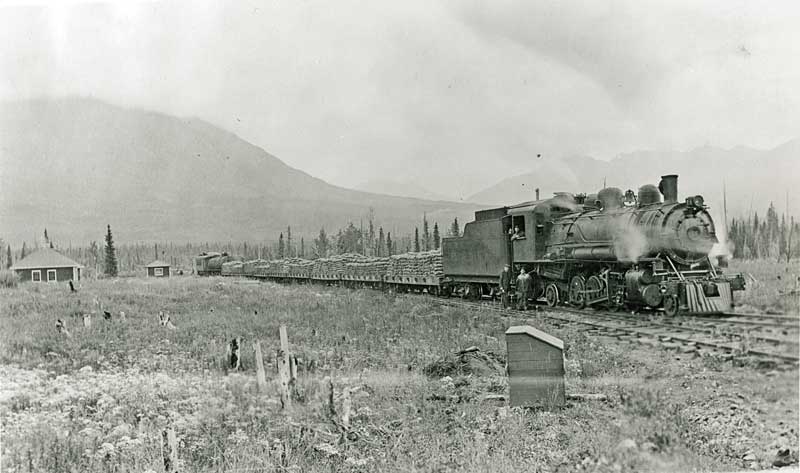 |
| A CRNW ore train passes Chokosna in the late 1930s |
On the Bonanza side, all the activity remained centered at Mother Lode, which was the deep extension of the Bonanza-Mother Lode orebody. The Bonanza incline which led to the 1,257 crosscut over to the Mother Lode incline remained in heavy use because it was the primary route for tramming the Mother Lode ore to the surface. The 800 level cross-cut, 450 feet above the newer cross-cut that connected directly into the Mother Lode incline shaft was last used to complete the exploration of the Marvelous ore bodies in 1927. The upper 1,200 vertical feet in the Bonanza was almost completely absent of activity while the Mother Lode 1,252 stope and other Mother Lode stopes adjacent to and below the Bonanza property continued to operate at a furious pace.
Although the engineers had concluded that the likelihood of finding additional rich ore bodies was remote, the company continued to drive the Mother Lode incline deeper, extending it well beyond the 1,600 level where the last major orebody had been located. Even with the failure of the 2,500 level cross-cut to produce new ore bodies, the engineers chose to continue the Mother Lode incline all the way to the 2,800 level. Nothing of interest was found anywhere in the last thousand vertical feet. That was the end of it.
As underground exploration expanded, production rapidly declined. The slump began to be reflected in the operation of the railroad. The CRNW quietly dropped daily service in the mid-1920s. Near-impossible conditions produced maintenance problems far exceeding anything encountered in the States. It earned the CR and NW the nickname “Can’t Run and Never Will.” Lapses in the schedule had long been accepted as normal. The ending of the daily train service went almost unnoticed. Soon the typical line of thirty-five flat cars became thirty, then twenty. A run of thirty cars every other day became the norm, then even that diminished sharply as the 1920s came to an end.
In 1924 the two-story Dwyers Inn at Strelna burned down, never to be replaced. Strelna, once considered the future hub for a mining district which contained the promising North Midas and Elliot-Hubbard Mines on the upper Kuskulana, was relegated to just another whistle-stop. These mines and most the others closed by the end of the 1920s. Early proposals to run branch lines up the Kuskulana and McCarthy Creek never even made the drawing board.
Traffic through McCarthy had begun to slow as the Chisana gold boom quickly became a bust. The other Nizina gold field operations continued, but they employed relatively few men. The Green Butte closed in 1925, and the road up McCarthy Creek was abandoned. McCarthy awaited an end that would shared with Kennecott. Chisana, Strelna, Chokosna, Chitina and Bremner never developed into the mining hubs that once seemed inevitable.
Traffic through Chitina had slowed to a crawl as freight and passengers from the Alaska Steamship Line developed a preference for Seward over Cordova, and for the new Alaska Railroad over the Copper River and Northwestern, which ended at Chitina instead of Fairbanks. Passengers arriving there found a rough wagon trail of 350 more miles if they wanted to reach Fairbanks. The surveyed route extending the Cordova Mainline from Chitina to Fairbanks became a historic footnote in 1914. The Hotel Chitina, which had been optimistically expanded to seventy rooms by 1917, became an early relic of a boom that had busted. All that remained was the business of the Kennecott copper mine itself. In 1924 it was not yet evident to many that a precipitous decline culminating in a full shut down had already begun.
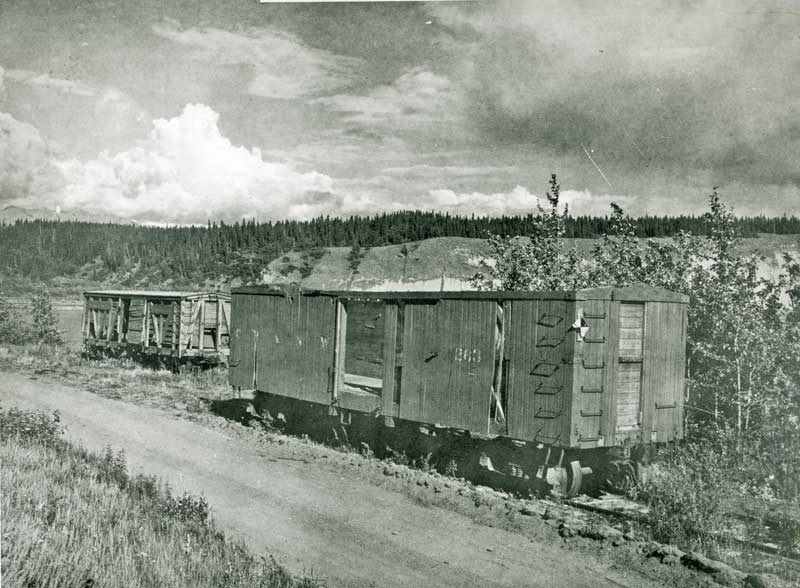 |
| Abandoned boxcars on Kotsina Hill east of Chitina --UAF Archives Continue with Chapter 45: "The Marvelous Assignment" |
Chapter 44: "Kennecott Goes into Subtle Decline," Pt 1
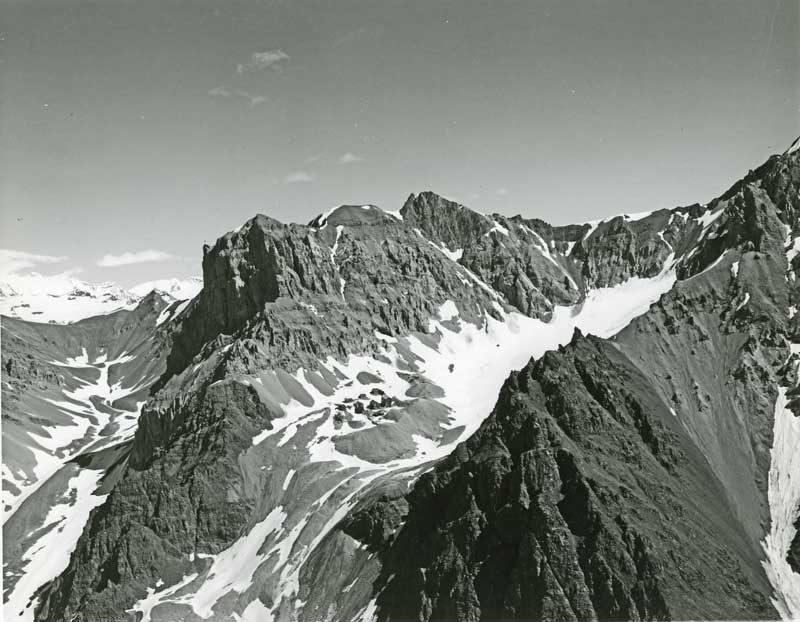 |
| Abandoned Jumbo Mine viewed from the air in 1955 --AMHA, Ward Wells Collection |
Subtle changes were taking place at Kennecott, which were obvious only to the engineers and their managers in the far away offices in downtown Seattle and at 120 Broadway in New York. Kennecott President Stephen Birch visited Kennecott for the last time in 1924 to evaluate the future of the Bonanza and the other mines. The inescapable conclusion was that all the major ore bodies had already been discovered and that the mine was now operating off of rapidly shrinking reserves. Even at that, the ore bodies were so extensive that the decline would not be obvious for years. Some never saw it at all. The consulting engineers estimated the remaining tonnage would take another eight years to extract, given a continued high rate of production.
From 1916 through 1925 the production was such that an ore train was required to operate six days a week, pulling at least thirty ore cars on each consist. The conditions under which the railroad had to operate required very high maintenance, but even so there were many weeks out of each year when the railway was inoperable. In most cases this was either due to extreme snow-drifting along the first hundred miles of the railroad or because the crossing at Chitina had gone out. The line was subject to frequent wash-outs, collapse of trestles and rail beds, avalanches, and problems with the tunnels.
The constant demand on the railroad had taken its toll on the track bed, the trestles and on aging rolling stock. The CRNW simply could not continue to operate as it had in the past without major investments to upgrade the system. Stephen Birch had already ruled out this possibility.
Had Birch and Stannard had their way, the mine would have closed by 1930 when they shut down the Beatson and Girdwood Mines on LaTouche Island. However, Alan Bateman, the senior mining consultant who replaced Wesley Dunkle, convinced the company not to purse a high speed withdrawal. Bateman preferred a twelve-year plan of retreat, not because the company was operating an aging railroad, but because he wanted more time for additional exploration. The consulting engineer wanted to be certain that every possibility of finding new ore bodies had been thoroughly exhausted.
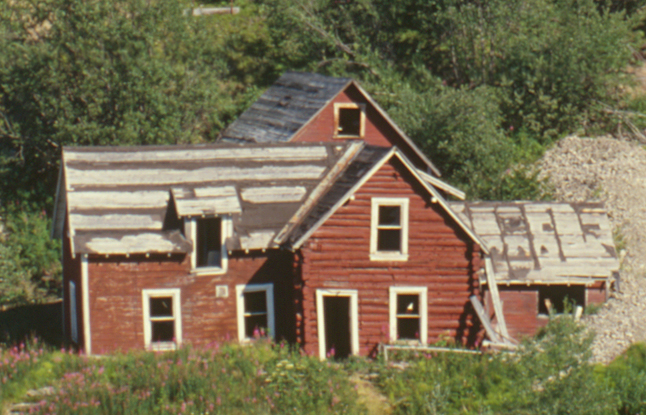 |
| The abandoned Kennecott general office in the ghost town of Kennecott in 1981 -Historic American Engineering Record |
In the end, it all became a matter of weighing the cost of continuing the operation of an aging and obsolete railroad system against the cost of extending the life span of the Bonanza, Jumbo and Mother Lode mines.
The Copper River and Northwestern Railway was never completed as intended. The temporary trestles made up nearly fifteen percent of the track grade from Cordova to Chitina. It remained that way for the twenty-seven years of railroad operation. Permanent steel bridges, contemplated to replace the larger wooden trestles, including the four-span Copper River crossing at Chitina, existed only as an engineering drawings, never to be built.
All the short-term fixes of those early years became permanent when it became apparent that the CRNW would never be anything more than a large mining railroad. Kennecott, the owner of the CRNW, decided it made more sense to maintain their aging trestles and other obsolete railroad features than to replace them. Unfortunately, no preservatives were used in the original trestle bents or the wooden ties. The company operated almost on a year-by-year basis, refusing to invest more than the absolute minimum amount of money required into their antiquated and increasingly inadequate system.
Large sections of the railway ran over old glacial remnants that were subject to severe melting, similar to the vast expanses of permafrost. None of the engineers understood how to build in such country. The most severe permafrost conditions existed around Strelna, but the problem extended along most of the Chitina Local branch from Chitina to Kennecott.
The snowsheds along Abercrombie contained heavy timber construction that deflected enormous snow loads, but these were eventually destroyed by the sheer weight of the overburden. They were not replaced after their destruction by heavy snows in 1931, the last year of winter railway service.
Railroad ties and trestle bents were constantly being replaced, while hundreds of thousands of cubic yards of gravel were dumped to stabilize other sections of the remote line.
No one knew how long the system could be kept patched together. The line was only one of a handful of sub-arctic railroads in existence. The engineers could only present expensive suggestions to fix on-going problems. What was clear was that it would always take up to 250 men to run the unproductive, money-losing railroad--about the same number required to run all the Kennecott mines at high production levels.
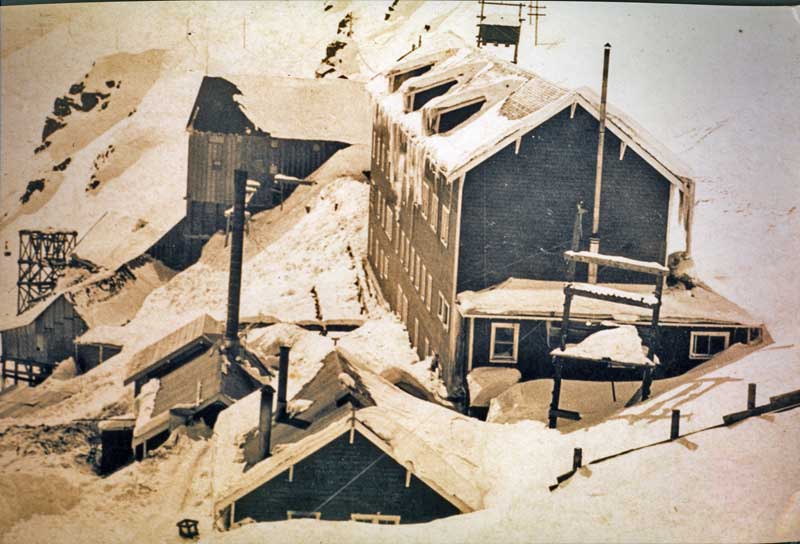 |
| Bonanza Mine --Simpson files |
It was the lingering possibility of finding additional rich ore which finally won out. Birch reluctantly opted for an extended plan of mining retreat in 1925. Because of this decision, the gradual exhaustion of the mines would go unnoticed to all but a few. A subtle withdrawal served the interests of Kennecott, who did not want to be left at the mercy of hostile labor elements who might seize on the opportunity to press for huge concessions. E.T.Stannard was prepared to shut down immediately and permanently if faced with a massive unionization of the mines and mill. The Great Man who built his career on Kennecott would never return. Without his personal interest, the milling and railway system began to crumble as corporate resources went elsewhere. Although Birch died three years after the end of Kennecott, Alaska, he was irrevokably linked with the remote mountain railroad and mine system and of Kennecott’s interest in the entire territory. He was the life force of Kennecott and the CRNW Railway. When Birch lost interest in the mine, the Alaskan properties became a doomed piece of a much larger Kennecott Corporation that had its genesis in the Wrangell Range.
Subscribe to:
Comments (Atom)
